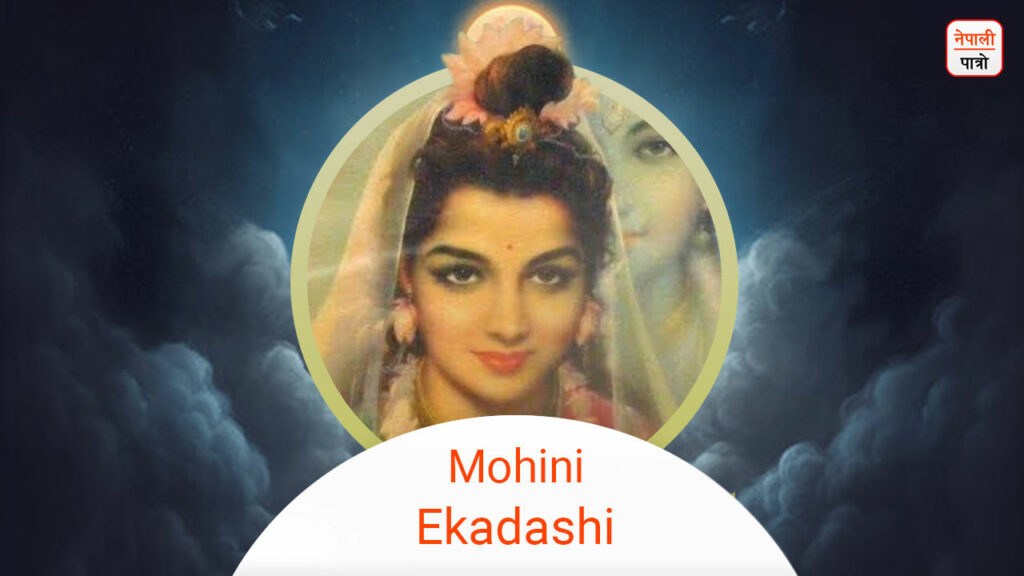
Mohini Ekadashi
The Ekadashi of Baishakh Shukla Pakchya is known as Mohini Ekadashi. Moha (attachment) is considered to be one of the great causes of sin in the Scriptures. Thus, the Mohini Ekadashi fast can be taken as a means to gain closeness to God while being free from delusional or attachment bondage.
Mohini Ekadashi Context
Lust, anger, desire, attachment, ego, and jealousy are six types of conduct that advocate in favor of sin, keeping people away from humanity and God. Therefore, these conducts are considered the main enemy of mankind. Through the fastings, such as of Ekadashi, the eleven senses can be controlled through the devotion of God by not indulging and carrying out such malice. In addition, by mitigating the corrupt thoughts and sinful feelings of the human mind, one can take the path of religion, sense, love, and salvation can be followed by kindness, compassion, goodwill, virtue, godly devotion, etc.
Shri Hari Bishnu is the adorable Lord of Ekadashi fast. During Ekadashi fast, the worshiper of all the worlds and all our hearts receive spiritual energy while worshiping, serving and contemplating Lord Shrihari, Lord of the Universe. The energy gained provides health, longevity, sharp wit, intense memory, and rapid reflexes.
Fasting, if possible once a week, if not once every fifteen days is useful to keep our body healthy and to stimulate the brain. During fasting, the active ingredients in the digestive system of our body, the intestines are relaxed and the body’s nerves become balanced and healthy. Since a light diet does not have much effect on the digestive system, one-day fasting and a light meal are very important as well as necessary for good health. It is also mentioned in the scriptures about fasting during Ekadashi, for the control plus relaxation of the eleven senses present in the body, which should be observed by complete fast or by consuming fruits only.
According to the scriptures, Lord Bishnu, born in the earth during the Treta Yuga (Treta epoch), acquired the knowledge of Mohini Ekadashi from his Guru Vashishta and observe the fast himself so as to explain its importance to the world. Later in the Dwapar era, as mentioned in the Puranas and scriptures Lord Shri Krishna told King Yudhishthira about the glory of the Mohini Ekadashi and advised him to observe it.
To calm down Yudhishthira’s curiosity, Shri Krishna has replied:- Baisakh Shukla Ekadashi’s name is Mohini Ekadashi, and after taking his vow, Ram, who was dismayed by separation from Sita, observed the fast, got rid of all the misery and got Sita back in his life. In the context of the story, Kul Guru (kul: a clan/ family. Guru: spiritual teacher) Vashishta Rishi impart Maryada Purushottam Shriram after he put forward his curiosity – Oh ram, what you ask is for public benefit, because of this information, the people of this world will find their way to the welfare of both life, this life and the one after it. So, I will tell you about the fast of Ekadashi including its benefit.
Says Vashisht Ji- Baisakh Shukla Ekadashi’s name is Mohini Ekadashi and before its fast and worship there was a king from a Som clan known as Dhutiman reigning a city called Bhadrawati. In the same place there lived a Sethji, a very wealthy and virtuous person named Dhanpal.
धनपाल इति ख्यातः पुण्यकर्म–प्रवर्तकः ।
प्रपासत्राद्यायतन–तडागारामकारकः ।।
The extremely religious wealthy Dhanpal had five sons. The youngest son’s name was Dhristabuddhi. The temperament of this son has changed from an early age to worse. The son became a sinner, cruel, adulterers, etc even after trying to persuade him as he did not change the rich man expelled his son from the kingdom. Upon his expulsion from the kingdom, he committed many sins and became involved in prostitution. As he was indulged in the company of prostitutes, he started selling valuables brought from his fathers’ kingdom as all his rings, diamonds, jewelers, etc. When the property was finished, the prostitutes also left him. He wandered alone in the woods. In this way he had a very abusive daily routine of killing, eating animals and moving from one jungle to another.
Dhristabuddhi while wandering through the jungle, because of the influence of virtue from his previous birth reached the ashram of a sage Koudinya. The sage, who was immersed in the daily activities of Baisakh month, entered the ashram after performing his daily bath in Gangaji, and a small drop of Ganga’s holy water of sage’s garments fell on the body of the sinful Dhristabuddhi. Gangaji pure holy herself and above that the water which had been touched by the saintly Koudinya sage when touched the body of the sinner Dhristabuddhi, he was completely cleansed from all sin, and evil.
माधवे मासि जान्हव्यां कृतस्नानं तपोधनम् ।
आससाद धृष्टबुद्धिः शोकभारेण पीडितः ।।
तद्वस्त्रविन्दुस्पर्शेन गतपाप्मा हताशुभः ।
कौडिन्यस्याग्रतः स्थित्वा प्रत्युवाच कृताञ्जलिः।।
Being an atheist, he began to ask the sage for the atonement for his sin and the way to be saved. Koudinya Sage says – this month on Baisakh Shuklapakchya, is Mohini Ekadashi. If you fast this Ekadashi then many of the sins born of birth are destroyed and purified and you will become pure soul thus can pave the way to Vaikuntha (Vishnu’s heaven). Dhristabuddhi started fasting, following the teachings of the sage. In connection with this story, Dhristabuddhi succeeded in becoming a better devotee of God by destroying worldly sins after the fasting rituals according to the Rishi’s command and destroying worldly sins through the effects of this fast. If such a vicious person goes to Vaikunth Loka (Vishnu’s heaven) by virtue of devout Ekadashi fasting destroying all sins, then one who practices fast from the pure heart will surely go to Vaikuntha.
दिव्यदेहस्ततो भूत्वा गरुडोपरिसंस्थितः ।
जगाम वैष्णवं लोकं सर्वोपद्रववर्जितम् ।।
Here, guru Vashisht after telling this story to Lord Sriram Chandra by preaching the sermon about Mohini fast to get back his wife Sita. Ram Chandraji also received Sitaji with the influence of Mohini fast and the blessing of kul guru Vasishtha.
In this way, the fast of Ekadashi seems to have given religion, sense, love, and salvation to the person observing it. Through various dialogues, it can be seen that, If you confess your mistakes in life, then the path of atonement is also found. Many messages can be obtained through the story of Mohini Ekadashi, such as spiritual advancement, worldly progress of oneself and one’s clan, and its achievement in the extraordinary or supernatural speed.
Fasting method
The candidate observing Mohini Ekadashi fasting should make a resolution to observe it with the pure mind without any temptations. In the morning, during early dawn one should get up, bathe, put on clean clothes and light a ghee lamp in front of Lord Bishnu’s statue, shaligram (fossils considered as an incarnation of Lord Bishnu) or his image and worship with water, Tulasi (Holy Basil), sesame, sandalwood paste, fruits with flowers. Contemplate his name, recite mantras and hear scriptures or stories related to Lord Bishnu. Do not have feelings of hatred toward anyone nor condemn anybody. Fasting throughout the whole day or consume fruits only after the evening offering. Even during the night, stay awake and sing praises to God. On the day of Dwadashi, early morning after customary offering and ritual worship concluding the Ekadashi fast by providing food to the Brahmins. Then eat normal pure food and be happy.
To Read this article in the Nepali Language please click here.
Related Posts
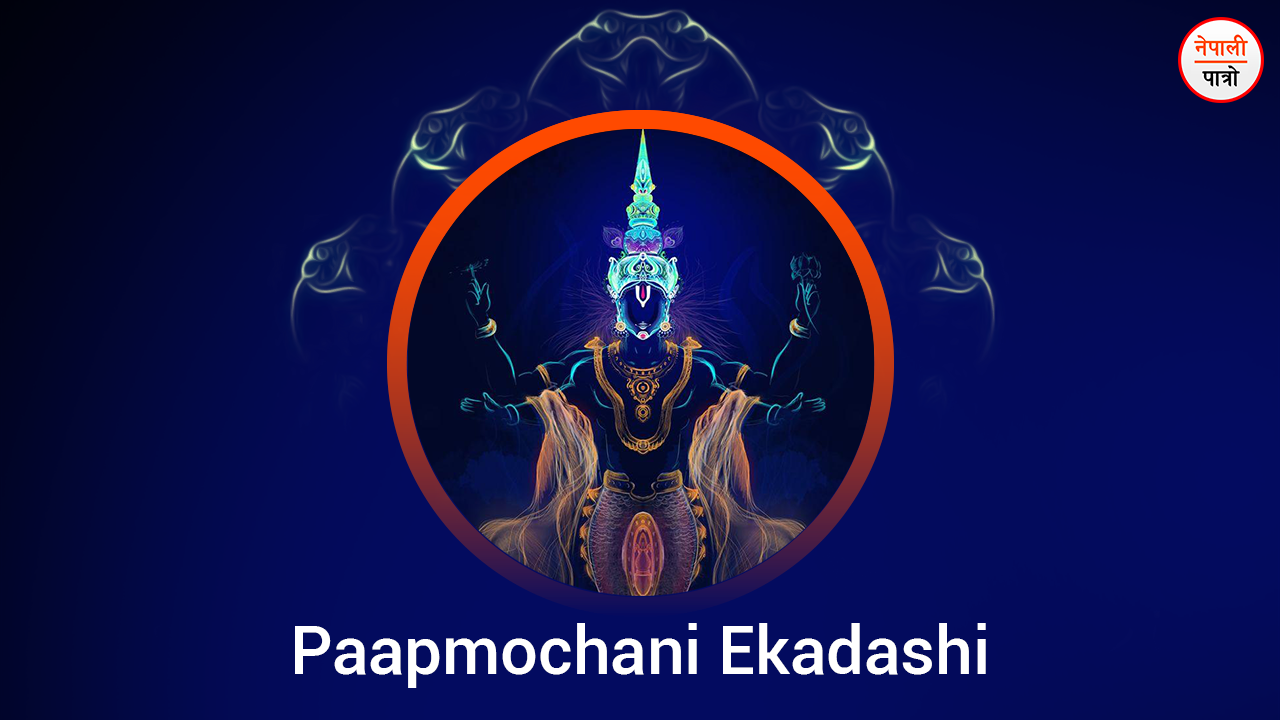 array(1) {
[0]=>
object(WP_Term)#2109 (16) {
["term_id"]=>
int(383)
["name"]=>
string(9) "Festivals"
["slug"]=>
string(12) "festivals-en"
["term_group"]=>
int(0)
["term_taxonomy_id"]=>
int(383)
["taxonomy"]=>
string(8) "category"
["description"]=>
string(440) "Festivals are celebrated on special days and dates by people of different castes and communities celebrating and worshiping different deities by having a feast etc. Melapat (social gathering), means trips, and festivals that bring people together. Jatra usually means the festival of god or goddess like Rath Yatra, Khat Yatra etc. Likewise, traditions refer to different Rituals, practises, and traditions that have long been practiced."
["parent"]=>
int(0)
["count"]=>
int(94)
["filter"]=>
string(3) "raw"
["cat_ID"]=>
int(383)
["category_count"]=>
int(94)
["category_description"]=>
string(440) "Festivals are celebrated on special days and dates by people of different castes and communities celebrating and worshiping different deities by having a feast etc. Melapat (social gathering), means trips, and festivals that bring people together. Jatra usually means the festival of god or goddess like Rath Yatra, Khat Yatra etc. Likewise, traditions refer to different Rituals, practises, and traditions that have long been practiced."
["cat_name"]=>
string(9) "Festivals"
["category_nicename"]=>
string(12) "festivals-en"
["category_parent"]=>
int(0)
}
}
festivals-en
Festivals
array(1) {
[0]=>
object(WP_Term)#2109 (16) {
["term_id"]=>
int(383)
["name"]=>
string(9) "Festivals"
["slug"]=>
string(12) "festivals-en"
["term_group"]=>
int(0)
["term_taxonomy_id"]=>
int(383)
["taxonomy"]=>
string(8) "category"
["description"]=>
string(440) "Festivals are celebrated on special days and dates by people of different castes and communities celebrating and worshiping different deities by having a feast etc. Melapat (social gathering), means trips, and festivals that bring people together. Jatra usually means the festival of god or goddess like Rath Yatra, Khat Yatra etc. Likewise, traditions refer to different Rituals, practises, and traditions that have long been practiced."
["parent"]=>
int(0)
["count"]=>
int(94)
["filter"]=>
string(3) "raw"
["cat_ID"]=>
int(383)
["category_count"]=>
int(94)
["category_description"]=>
string(440) "Festivals are celebrated on special days and dates by people of different castes and communities celebrating and worshiping different deities by having a feast etc. Melapat (social gathering), means trips, and festivals that bring people together. Jatra usually means the festival of god or goddess like Rath Yatra, Khat Yatra etc. Likewise, traditions refer to different Rituals, practises, and traditions that have long been practiced."
["cat_name"]=>
string(9) "Festivals"
["category_nicename"]=>
string(12) "festivals-en"
["category_parent"]=>
int(0)
}
}
festivals-en
Festivals
Paapmochani Ekadashi
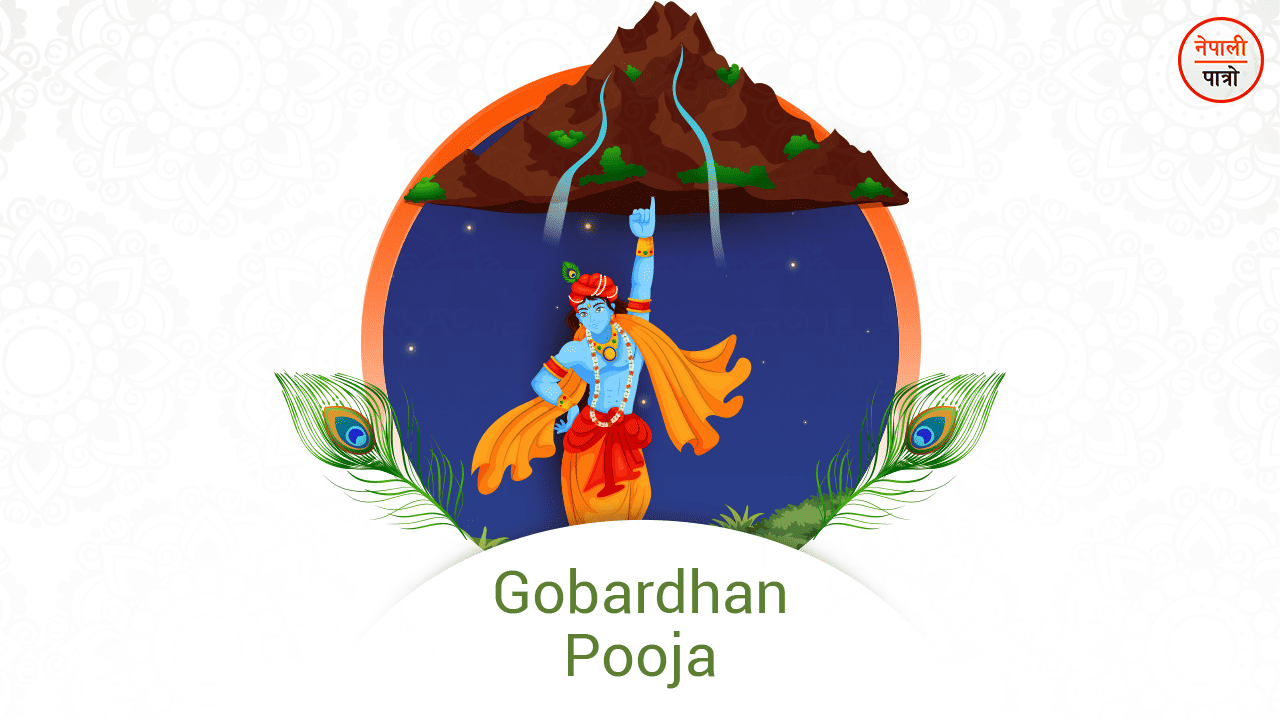 array(1) {
[0]=>
object(WP_Term)#2110 (16) {
["term_id"]=>
int(383)
["name"]=>
string(9) "Festivals"
["slug"]=>
string(12) "festivals-en"
["term_group"]=>
int(0)
["term_taxonomy_id"]=>
int(383)
["taxonomy"]=>
string(8) "category"
["description"]=>
string(440) "Festivals are celebrated on special days and dates by people of different castes and communities celebrating and worshiping different deities by having a feast etc. Melapat (social gathering), means trips, and festivals that bring people together. Jatra usually means the festival of god or goddess like Rath Yatra, Khat Yatra etc. Likewise, traditions refer to different Rituals, practises, and traditions that have long been practiced."
["parent"]=>
int(0)
["count"]=>
int(94)
["filter"]=>
string(3) "raw"
["cat_ID"]=>
int(383)
["category_count"]=>
int(94)
["category_description"]=>
string(440) "Festivals are celebrated on special days and dates by people of different castes and communities celebrating and worshiping different deities by having a feast etc. Melapat (social gathering), means trips, and festivals that bring people together. Jatra usually means the festival of god or goddess like Rath Yatra, Khat Yatra etc. Likewise, traditions refer to different Rituals, practises, and traditions that have long been practiced."
["cat_name"]=>
string(9) "Festivals"
["category_nicename"]=>
string(12) "festivals-en"
["category_parent"]=>
int(0)
}
}
festivals-en
Festivals
array(1) {
[0]=>
object(WP_Term)#2110 (16) {
["term_id"]=>
int(383)
["name"]=>
string(9) "Festivals"
["slug"]=>
string(12) "festivals-en"
["term_group"]=>
int(0)
["term_taxonomy_id"]=>
int(383)
["taxonomy"]=>
string(8) "category"
["description"]=>
string(440) "Festivals are celebrated on special days and dates by people of different castes and communities celebrating and worshiping different deities by having a feast etc. Melapat (social gathering), means trips, and festivals that bring people together. Jatra usually means the festival of god or goddess like Rath Yatra, Khat Yatra etc. Likewise, traditions refer to different Rituals, practises, and traditions that have long been practiced."
["parent"]=>
int(0)
["count"]=>
int(94)
["filter"]=>
string(3) "raw"
["cat_ID"]=>
int(383)
["category_count"]=>
int(94)
["category_description"]=>
string(440) "Festivals are celebrated on special days and dates by people of different castes and communities celebrating and worshiping different deities by having a feast etc. Melapat (social gathering), means trips, and festivals that bring people together. Jatra usually means the festival of god or goddess like Rath Yatra, Khat Yatra etc. Likewise, traditions refer to different Rituals, practises, and traditions that have long been practiced."
["cat_name"]=>
string(9) "Festivals"
["category_nicename"]=>
string(12) "festivals-en"
["category_parent"]=>
int(0)
}
}
festivals-en
Festivals
Gobardhan Puja
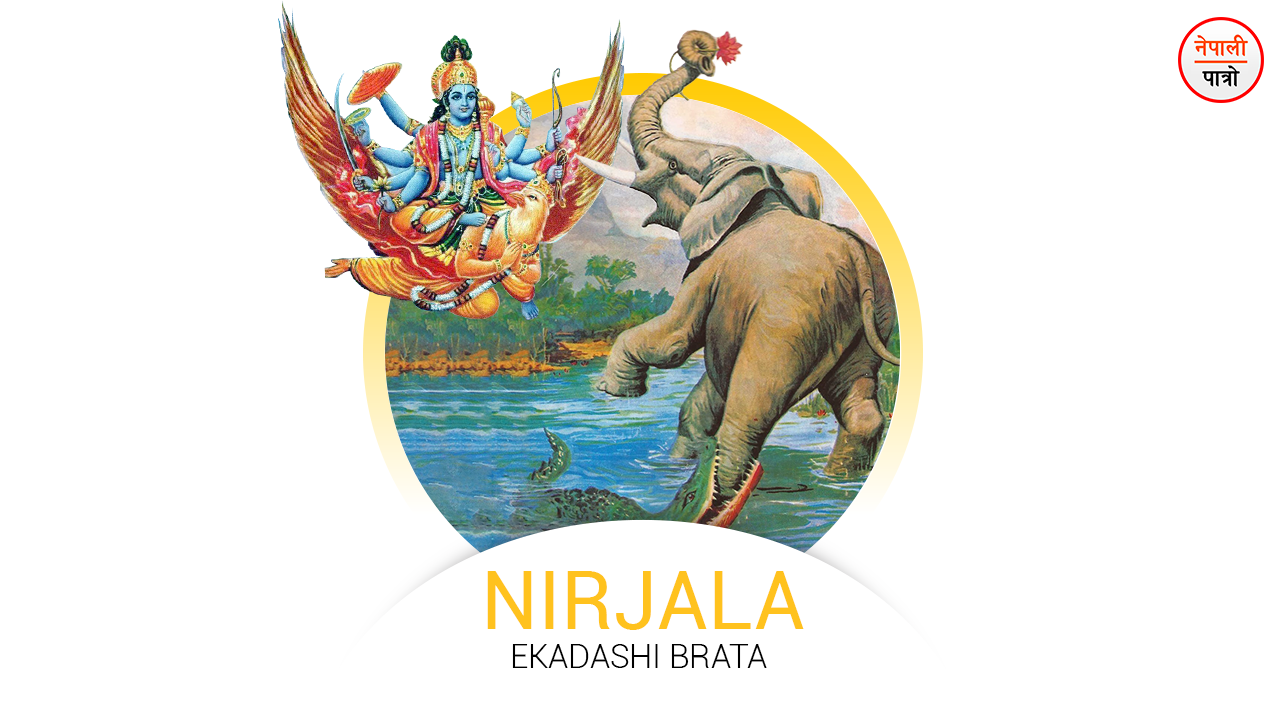 array(1) {
[0]=>
object(WP_Term)#2111 (16) {
["term_id"]=>
int(383)
["name"]=>
string(9) "Festivals"
["slug"]=>
string(12) "festivals-en"
["term_group"]=>
int(0)
["term_taxonomy_id"]=>
int(383)
["taxonomy"]=>
string(8) "category"
["description"]=>
string(440) "Festivals are celebrated on special days and dates by people of different castes and communities celebrating and worshiping different deities by having a feast etc. Melapat (social gathering), means trips, and festivals that bring people together. Jatra usually means the festival of god or goddess like Rath Yatra, Khat Yatra etc. Likewise, traditions refer to different Rituals, practises, and traditions that have long been practiced."
["parent"]=>
int(0)
["count"]=>
int(94)
["filter"]=>
string(3) "raw"
["cat_ID"]=>
int(383)
["category_count"]=>
int(94)
["category_description"]=>
string(440) "Festivals are celebrated on special days and dates by people of different castes and communities celebrating and worshiping different deities by having a feast etc. Melapat (social gathering), means trips, and festivals that bring people together. Jatra usually means the festival of god or goddess like Rath Yatra, Khat Yatra etc. Likewise, traditions refer to different Rituals, practises, and traditions that have long been practiced."
["cat_name"]=>
string(9) "Festivals"
["category_nicename"]=>
string(12) "festivals-en"
["category_parent"]=>
int(0)
}
}
festivals-en
Festivals
array(1) {
[0]=>
object(WP_Term)#2111 (16) {
["term_id"]=>
int(383)
["name"]=>
string(9) "Festivals"
["slug"]=>
string(12) "festivals-en"
["term_group"]=>
int(0)
["term_taxonomy_id"]=>
int(383)
["taxonomy"]=>
string(8) "category"
["description"]=>
string(440) "Festivals are celebrated on special days and dates by people of different castes and communities celebrating and worshiping different deities by having a feast etc. Melapat (social gathering), means trips, and festivals that bring people together. Jatra usually means the festival of god or goddess like Rath Yatra, Khat Yatra etc. Likewise, traditions refer to different Rituals, practises, and traditions that have long been practiced."
["parent"]=>
int(0)
["count"]=>
int(94)
["filter"]=>
string(3) "raw"
["cat_ID"]=>
int(383)
["category_count"]=>
int(94)
["category_description"]=>
string(440) "Festivals are celebrated on special days and dates by people of different castes and communities celebrating and worshiping different deities by having a feast etc. Melapat (social gathering), means trips, and festivals that bring people together. Jatra usually means the festival of god or goddess like Rath Yatra, Khat Yatra etc. Likewise, traditions refer to different Rituals, practises, and traditions that have long been practiced."
["cat_name"]=>
string(9) "Festivals"
["category_nicename"]=>
string(12) "festivals-en"
["category_parent"]=>
int(0)
}
}
festivals-en
Festivals
Nirjala Ekadashi Brat
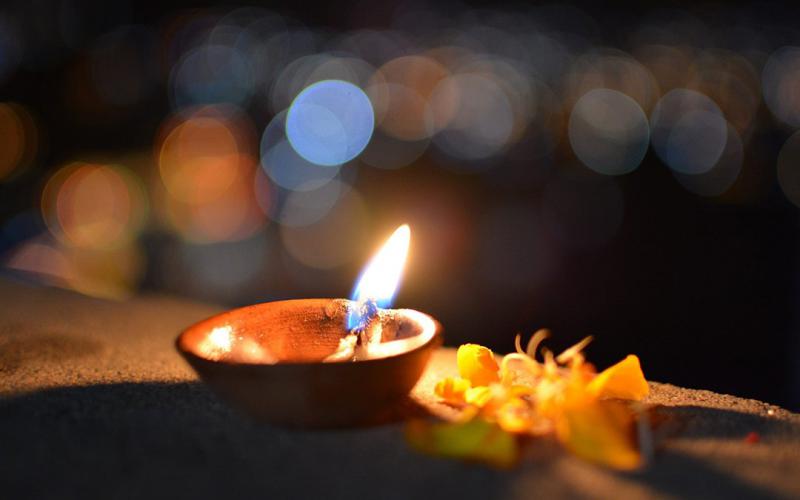 array(1) {
[0]=>
object(WP_Term)#2093 (16) {
["term_id"]=>
int(383)
["name"]=>
string(9) "Festivals"
["slug"]=>
string(12) "festivals-en"
["term_group"]=>
int(0)
["term_taxonomy_id"]=>
int(383)
["taxonomy"]=>
string(8) "category"
["description"]=>
string(440) "Festivals are celebrated on special days and dates by people of different castes and communities celebrating and worshiping different deities by having a feast etc. Melapat (social gathering), means trips, and festivals that bring people together. Jatra usually means the festival of god or goddess like Rath Yatra, Khat Yatra etc. Likewise, traditions refer to different Rituals, practises, and traditions that have long been practiced."
["parent"]=>
int(0)
["count"]=>
int(94)
["filter"]=>
string(3) "raw"
["cat_ID"]=>
int(383)
["category_count"]=>
int(94)
["category_description"]=>
string(440) "Festivals are celebrated on special days and dates by people of different castes and communities celebrating and worshiping different deities by having a feast etc. Melapat (social gathering), means trips, and festivals that bring people together. Jatra usually means the festival of god or goddess like Rath Yatra, Khat Yatra etc. Likewise, traditions refer to different Rituals, practises, and traditions that have long been practiced."
["cat_name"]=>
string(9) "Festivals"
["category_nicename"]=>
string(12) "festivals-en"
["category_parent"]=>
int(0)
}
}
festivals-en
Festivals
array(1) {
[0]=>
object(WP_Term)#2093 (16) {
["term_id"]=>
int(383)
["name"]=>
string(9) "Festivals"
["slug"]=>
string(12) "festivals-en"
["term_group"]=>
int(0)
["term_taxonomy_id"]=>
int(383)
["taxonomy"]=>
string(8) "category"
["description"]=>
string(440) "Festivals are celebrated on special days and dates by people of different castes and communities celebrating and worshiping different deities by having a feast etc. Melapat (social gathering), means trips, and festivals that bring people together. Jatra usually means the festival of god or goddess like Rath Yatra, Khat Yatra etc. Likewise, traditions refer to different Rituals, practises, and traditions that have long been practiced."
["parent"]=>
int(0)
["count"]=>
int(94)
["filter"]=>
string(3) "raw"
["cat_ID"]=>
int(383)
["category_count"]=>
int(94)
["category_description"]=>
string(440) "Festivals are celebrated on special days and dates by people of different castes and communities celebrating and worshiping different deities by having a feast etc. Melapat (social gathering), means trips, and festivals that bring people together. Jatra usually means the festival of god or goddess like Rath Yatra, Khat Yatra etc. Likewise, traditions refer to different Rituals, practises, and traditions that have long been practiced."
["cat_name"]=>
string(9) "Festivals"
["category_nicename"]=>
string(12) "festivals-en"
["category_parent"]=>
int(0)
}
}
festivals-en
Festivals
May 13, 2022 2 years
हो म पनि मोह लगाउँछु